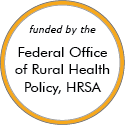Rural Pharmacy and Prescription Drugs – Models and Innovations
These stories feature model programs and successful rural projects that can serve as a source of ideas and provide lessons others have learned. Some of the projects or programs may no longer be active. Read about the criteria and evidence-base for programs included.
Effective Examples
Project Lazarus
Updated/reviewed May 2024
- Need: To reduce overdose-related deaths among prescription opioid users in rural Wilkes County, North Carolina.
- Intervention: Education and tools are provided for prescribers, patients and community members to lessen drug supply and demand, and to reduce harm in prescription opioid use.
- Results: Opioid overdose death rates have decreased in Wilkes County.
Other Project Examples
Queen Anne's County Mobile Integrated Community Health (MICH) Program
Updated/reviewed May 2025
- Need: To connect patients to resources in order to reduce use of emergency services, emergency department visits, and hospital readmissions.
- Intervention: Patients receive support (by in-person visit, phone call, or telehealth visit) from a paramedic, community health nurse, peer recovery specialist, and pharmacist.
- Results: Between July 2016 and March 2024, the program made 1,098 patient contacts and continued to see a reduction in emergency department and inpatient visits and costs.
Ohio Northern University's HealthWise Mobile Outreach Program

Updated/reviewed July 2019
- Need: Meeting both advanced practice pharmacy student education needs and patient healthcare needs in a nearby rural/underserved area.
- Intervention: With support from multiple organizations, students in the Ohio Northern University's College of Pharmacy program use a motor coach to deliver a wide range of healthcare services during scheduled outreach visits.
- Results: In the program's first two years, point-of-care screening, immunizations, and chronic disease prevention and management education have been provided to 800+ Hardin County, Ohio, residents.
Last Reviewed: 1/7/2025

